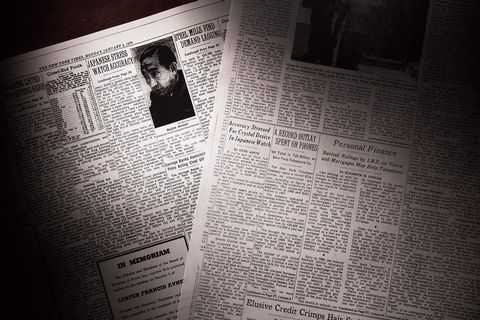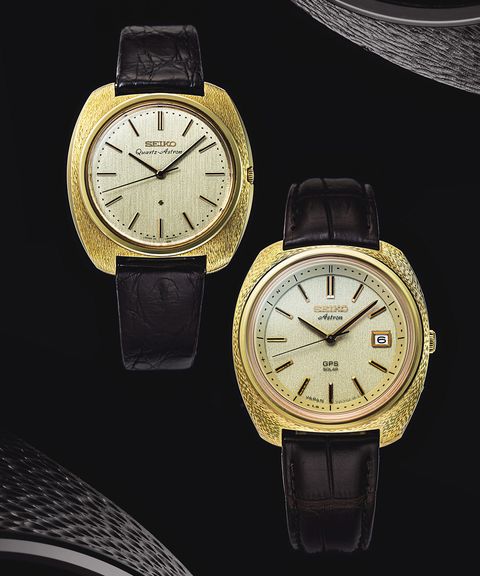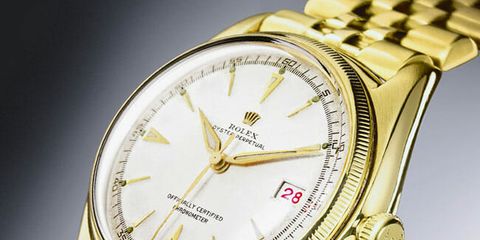Welcome to Watches You Should Know, a column highlighting important or little-known watches with interesting backstories and unexpected influence. This week: the 1969 Seiko Quartz Astron.
Many of the cheapest watches you can buy are more accurate and reliable than the most expensive ones. That ironic dichotomy is made possible in part by a little technology known as the quartz movement, and it all started with a watch released on Christmas Day 1969 in Japan. The Seiko Quartz Astron 35SQ, as it was called, was marketed with the bold promise: "Someday, all watches will be made this way."
That first Astron was functionally and aesthetically simple, with an elegant mixture of finishes on its gold case and a brushed dial texture. Although it would precipitate a revolution in the industry when mass production eventually became cheaper, the first Astron watches were more expensive than many mechanical watches of the time. It's said to have been equivalent in price to a midsized car at JPY450,000.
Quartz Accuracy in a Wristwatch Was Revolutionary
Of course, the Astron was notable for its accuracy more than its looks. Though still far more accurate than mechanical watches, the movement inside wasn't the exact same technology that's commonly found in quartz watches today. Here are some numbers for context: Most modern quartz operates at 32,768Hz whereas the frequency of the 1969 Astron was a quarter of that figure, at 8,192Hz. But compare that number to standard mechanical watches that run at 4Hz. Those hertz (Hz) numbers refer to oscillations per second — in mechanical watches it's the oscillation of a swinging wheel, and in quartz watches it's the oscillation of a vibrating crystal.
The practical result in the Astron was an accuracy of +/-5 seconds per month, whereas that much deviation in a day ain't bad in a mechanical watch. Quartz proved to be slimmer, and fewer moving parts also made it more robust, particularly when solid state electronics were later added. Quartz's technical superiority is clear, and when it became more efficient and cost-effective to produce it, it was a no-brainer for consumers — and created what became known as the "Quartz Crisis" for the traditional watch industry. It's said that Swiss watch companies numbered around 1,600 in 1970 and fell to 600 by 1983; employment in the industry fell from 90,000 (1970) to 28,000 in 1988.
The Swiss Weren't Far Behind
A cursory understanding of the so-called Quartz Crisis might suggest that Seiko (or more broadly the Japanese watch industry) simply came along with inexpensive mass production and undercut the Swiss watch industry. However, it's not as if Swiss companies were blindsided by the advent of quartz. A consortium of about 20 Swiss companies had been collaborating on a quartz movement — eventually called the Beta 21 — for years and introduced a prototype (the Beta 1) in 1967 (Seiko produced a prototype of the Astron the same year). So this could be seen as a race that Seiko simply won.
The various elements of the technology used in quartz movements didn't exactly come out of nowhere, either: Companies had been experimenting with battery-powered electric watches for years, Hamilton having introduced the first example in 1957. Seiko was the first to commercially release a quartz movement that fit in a wristwatch, but it built upon existing innovations — for example, the first quartz clock had been built in 1927 at Bell Laboratories.
Shockwaves for an Industry Built on Mechanical Clockwork
It wasn't the Japanese or Seiko that bulldozed the watch industry, but the relentless forward march of technology itself. The Astron was merely the crest of the quartz wave. Unlike later quartz watches, the Seiko Quartz Astron 35SQ of 1969 was not mass produced or inexpensive. It was years before quartz became easy and cheap to mass produce, and this is what really made mechanical watchmaking obsolete: not only was quartz vastly superior for timekeeping, but it was far cheaper.
For an industry that had been using the same technology of springs and gears for centuries, the emergence of quartz was a shock indeed. The infrastructure built around traditional watchmaking suddenly seemed irrelevant, leading many companies to shutter for good and many jobs to be lost. How mechanical watches were reinvented as luxury items and made the magnificent comeback that's evident at present is a story for another day.
Modern watches and collecting are full of irony and vicissitudes. Quartz was first celebrated, then disdained by collectors for its association with cheap mass production. Now, the very same culture of enthusiasm that drew enthusiasts back to mechanical timekeeping has led to a renewed appreciation and nostalgia for quartz watches, even among the snobs.
The Legacy of the Astron Today
Seiko was at the forefront of a technology that had a momentum of its own, but its pioneering contribution shouldn't be overlooked. The brand has consistently been on the technological cutting edge (in the very same year as the Astron's debut, 1969, Seiko also beat various other companies to market with the first automatic chronograph movement). A further evolution of quartz is Seiko's utterly unique type of hybrid movement called Spring Drive that uses a spring for power like a mechanical watch but is regulated by a quartz oscillator.
Today, Seiko's Astron collection bears little resemblance to the 1969 model. It's produced alongside the brand's own many mechanical offerings and continues to push the boundaries of timekeeping tech with the likes of solar charging, GPS reception and atomic-clock accuracy automatically adjusting as you cross time zones.





















